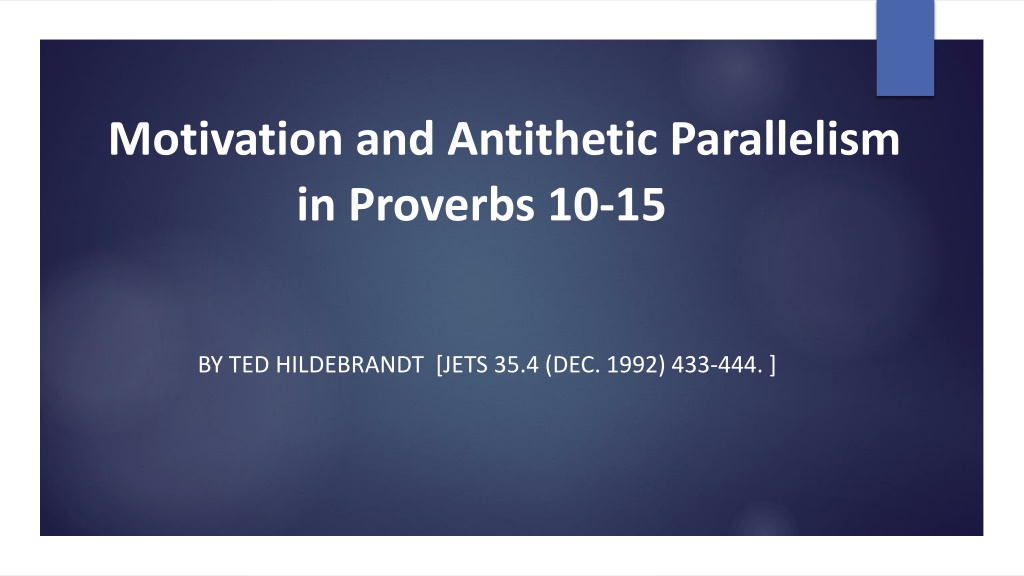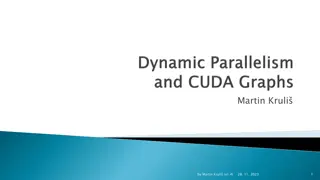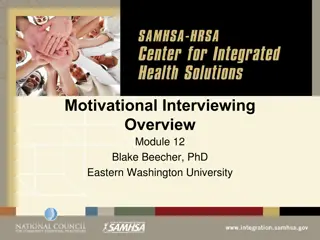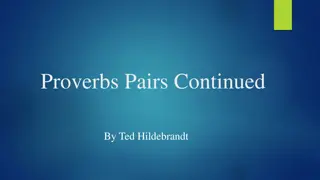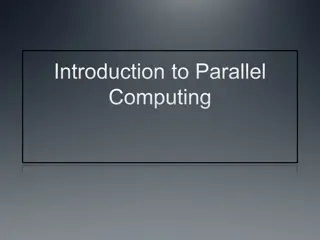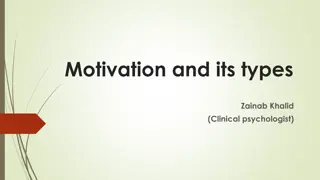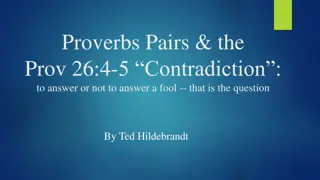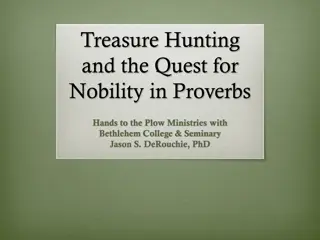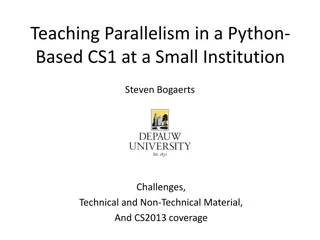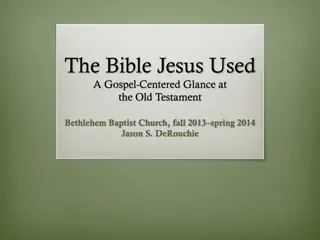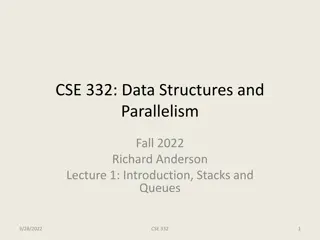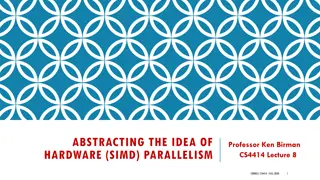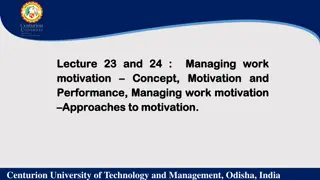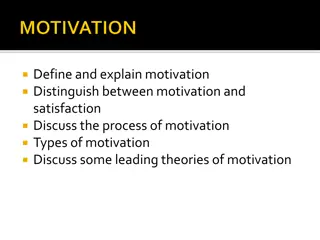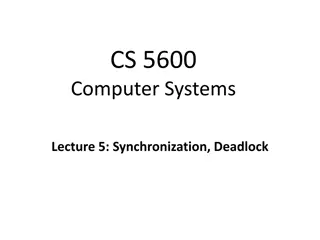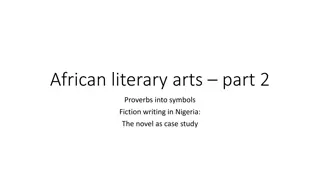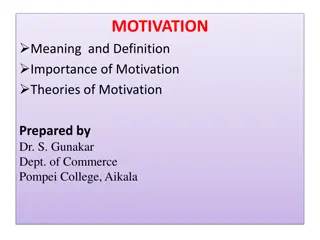Understanding Motivation and Antithetic Parallelism in Proverbs 10-15 by Ted Hildebrandt
Exploring the methods of motivating students, children, and individuals through the use of motive clauses in biblical wisdom literature, specifically focusing on Proverbs 10-15. The discussion delves into the historical context and examples of motive clauses found in biblical admonitions, highlighting the different categories of motives for encouraging wise behavior.
Download Presentation

Please find below an Image/Link to download the presentation.
The content on the website is provided AS IS for your information and personal use only. It may not be sold, licensed, or shared on other websites without obtaining consent from the author. Download presentation by click this link. If you encounter any issues during the download, it is possible that the publisher has removed the file from their server.
E N D
Presentation Transcript
Motivation and Antithetic Parallelism in Proverbs 10-15 BY TED HILDEBRANDT [JETS 35.4 (DEC. 1992) 433-444. ]
1. Introductory Questions How did the proverbial sage motivate his students? How can a father and mother best motivate their children? How did Solomon structure his wisdom and motivate others to pursue wisdom?
2. What is a Motive Clause? Prov 16:12 It is an abomination to kings to do evil, + Motive clause = for [ - ki]the throne is established by righteousness. 1A. History of the study of Motive Clauses: Gemser 1953 Motive clauses unique to Israel; maybe not totally unique but not frequently used in ANE materials. Sonsino and Utti: 30% of biblical laws motivated (375 of 1,238 commands) ANE law codes only 5-6% motivated. Contrary to legal materials in ANE Wisdom Literature high level of motivation clauses--Sumerian: Instruction of Shuruppak; Akkadian Counsels of Wisdom; Egyptian: Ani, Ptahhotep, Ugartic: Instructions of Shube-Awilum
Examples of biblical Admonition + Motive Clauses: 1B. Ki - Exod. 20:7 Admonition: You shall not take the name of the LORD your God in vain, // + (motive clause)for[ - ki] the LORD will not hold him guiltless who takes his name in vain. ESV Amos 5:4-5; Jer 4:6-8; Ps. 95:3-7 Ki -- most frequent by far Prov 3: 1 Admonition: My son, do not forget my teaching, but let your heart keep my commandments, // years of life and peace they will add to you. 2 + (motive clause) for [ ] length of days and
Examples of biblical Admonition + Motive Clauses: 2B. Pen/lest - Ps 2:12Admonition: Kiss the Son, // + Motive Clause: lest [ - pen] he be angry, and you perish in the way, for [ ] his wrath is quickly kindled. ESV 3B. Lev. 23:43 Israelites shall dwell in booths, // 43that [ ] your generations may know that I made the people of Israel dwell in booths when I brought them out of the land of Egypt: I am the LORD your God. 42You shall dwell in booths for seven days. All native
Gemsers 4 categories of Motives: 1B. Explanatory Character (Deut. 20:5-8; 22:24, 26; Prov 19:25, 27; 22:6) Prov. 19:25 Strike a scoffer,// and the simple will learn prudence; - motive reprove a man of understanding,// and he will gain knowledge. - motive Prov 22:6 Train up a child in the way he should go; // and when he is old he will not depart from it. - motive 2B. Ethical Content: Deut 5:14-15; 19:21 Deut 19:21 Your eye shall not pity.// It shall be life for life, eye for eye, tooth for tooth, hand for hand, foot for foot. - motive
Gemsers 4 categories of Motives: 3B. Cultic/Theological: Deut 17:1; 22:5; Prov 20:22; 22:24-25 Prov 20:22 Do not say, I will repay evil ; // wait for the LORD, and he will deliver you. - motive 4B. Historical: Lev 19:33-34; Deut 5:15 Lev. 19:34 You shall treat the stranger who sojourns with you as the native among you, and you shall love him as yourself, // for you were strangers in the land of Egypt: I am the LORD your God. motive No historical motives in Proverbs
Motives in Proverbs Postel also notes: the Abomination clause is often in the law motivation while used in Proverbs but not in explicit motive clauses: [cf. 11:1, 20; 12:22; 15:8-9; 19:15; 20:10) -- shows surface grammatical analysis doesn t get at deep level motivational intent need for deep structure analysis not just Ki-motive clauses (surface grammar). Deut 7:25 The carved images of their gods you shall burn with fire. You shall not covet the silver or the gold that is on them or take it for yourselves, lest you be ensnared by it, for [ -ki ] it is an abomination to the LORD your God
Motives in Proverbs Prov 11:1 A false balance //is an abomination to the LORD, - motive but a just weight // is his delight. motive T = Theological; E= Explanatory; C= Consequential with Valence: + / - P= Promissory and D = Dissuasive Remember: A proverb is not a promise. [Basic principle] E.g. Prov 10:2 Treasures gained by wickedness do not profit, but righteousness delivers from death. tell that to John the Baptist or Jeremiah A proverb is not a promise guaranteed way things generally work
Motives in Proverbs 1B. Admonitions mostly in the Instructions section of Proverbs Prov. 1-9 Prov. 1-9=39; Prov 10-22 = 13 [e.g. 14:7; 16:3; 19:18; 20:18-19; 22:6] Often Admonition + Motive Clause (Prov 1:15-16; 3:1-2, 25-26) Prov 1:15f ADMONITION: My son, do not walk in the way with them; hold back your foot from their paths, + Motive: for their feet run to evil, and they make haste to shed blood. Prov 3:1-2 My son, do not forget my teaching, Admonition but let your heart keep my commandments, and peace they will add to you. 2for [ ] length of days and years of life Motive Clause
Motives in Proverbs 14:7 Leave the presence of a fool, Admonition motive: for (vav:and) there you do not meet words of knowledge. 13 of the 17 motive clauses are in admonitions in Prov 10-22. only 4 not in admonitions: 13:14; 14:27; 15:24; 16:24 13:14The teaching of the wise is a fountain of life, Not an admonition + motiveto[ ] turn away from the snares of death.
Motives in Proverbs 2B. Ratios: Motive clauses: 5.3% Prov 10-22 proverbial sentence; evenly distributed 12% in Prov 25-29. Mostly consequential 77.5% in Prov 22:17-24:22 (more instructional section) -- heavily theological
Motives in Proverbs 3A. Clear relationship between admonitions and sentences in some of the duplicate proverbs where one formed as an admonition and the other as a sentence proverb 1B. Prov 22:22-23 with explicit admonition + motive clause Prov 22:22-23 Do not rob the poor, because he is poor, or crush the afflicted at the gate, Admonition and rob of life those who rob them. 23for [ ] the LORD will plead their cause Motive Clause
Motives in Proverbs 2B. As a sentence 14:31 without explicit motive clause but clearly motivational Prov 14:31 Whoever oppresses a poor man // insults his Maker, but he who is generous to the needy // honors him.
Motives in Proverbs 4A. Many of the sentence proverbs go beyond merely empirical observation to being motivationally directive. Thus one must go beyond clearly marked grammatical motive clauses to the underlying deep structure.
Motives in Proverbs sentence sayings 3. Methodology of exposing deep structure motivation in sentence sayings/proverbs No motive clause yet clearly motivational 1A. Break the sentence up into: Topic + Comment: Prov 10:1 Topic Comment A wise son brings joy to his father A foolish son is a grief to his mother.
Motives in Proverbs sentence sayings 2A. Add deep structure + Valence (+ or motivation: approach/attraction//avoidance) Topic A wise son (+ character) A foolish son (- character) brings joy to his father (+ consequence) is a grief to his mother. (- consequence) Comment + Character + ConSequence CS++ - Character - ConSequence CS --
Motives in Proverbs sentence sayings 3A. Prov 11:15 Topic He who puts up security for another (- act) whoever refuses to strike hands in pledge (+ act) Comment will surely suffer (- consequence) is safe (+ consequence) -Act - ConSequence (AS) -- +Act + ConSequence (AS) ++
Deep Structure Classifications 8 categories Prov 10:20a The tongue of the righteous // is choice silver; +C +E Topic Comment 1) Character ConSequence(CS) 152 Prov 10:2b but righteousness // delivers from death. +C +S 2) Character Act(CA) 70 Prov 10:14a Wise // lay up knowledge, +C +A 3) Character Evaluation (CE) Frequency Examples 10:2b, 3a, 6a 10:14a 16 10:20a; 11:1a
Deep Structure Classifications 4) Acts +Act +S 5) Item Prov 13:2a From the fruit of his mouth // a man eats what is good, +I +S 6) Item Evalution (IE) Prov 10:15a A rich man s wealth // is his strong city; +I +E ConSequence (AS) 63 Prov 10:17a Whoever heeds instruction // is on the path to life, 10:17a, 19a ConSequence (IS) 12 13:2a, 8a 7 10:15a; 13:19a
Deep Structure Classifications 7) Act Prov 12:1a Whoever loves discipline // loves knowledge +A +E 8) APpearance Reality (PR) 4 Prov 13:7 One pretends to be rich, // yet has nothing; another pretends to be poor, // yet has great wealth. P -R / P +R Evaluation (AE) 13 11:30b; 12:1a Act What this shows is Character core in the proverbial sentence 13:7; 14:13 Conclusion: Koch and Von Rad proverbial sentences basically Consequence [62x] central core Consequence [152x] more central
Deep Structure Classifications Significance: So What: Importance of linking character or acts to consequence for wise young people. What you choose has significant consequences. Acts and character are connected to consequences. Our culture: acts/character have no consequences (everyone gets a trophy; make a mistake no problem no consequences (no bail just walk out free). Why should I be wise/righteous/diligent it doesn t make any difference? (fool s thoughts). Wise kids know acts/character have consequences and when you decide on something you need to think about the consequences it will have.
5. Motivation and Antithetic Parallelism Postel s promissory and dissuasive valences for Proverbs could be coordinated with motivational theory: approach/attraction motivation and avoidance motivation. Featuring the binary +/- nature of much of proverbs 2A. Why should sages in producing wisdom literature show such a preference to antithetic parallelism 90% of Proverbs 10-15; cf. also Ps. 1 1A.
5. Motivation and Antithetic Parallelism A- B- C A foolish son A+ B+ C A wise son gives joy to a father Prov 10:1 is a grief to his mother Ps. 1:6 ABBA chiasm for the LORD knows B- A- but the way of the wicked will perish A+ B+ the way of the righteous,
5. Motivation and Antithetic Parallelism Antithetic parallelismprovides a perfect psycholinguistic structure for doubling the motivational potency of the sentences by combining an additive sense of approach/attraction and avoidance motivations.
5. Motivation and Antithetic Parallelism 3A. Mark Sneed notes that most proverbs outside of the book of Proverbs are one-line sayings. E.g. Judg 8:21; 1 Sam 24:13; 2 Sam 5:6; 1 Kgs 20:11 vid. Carol Fontaine s book on Traditional Sayings in the Old Testament; Sneed in Dell s Biblical Wisdom Literature p. 85. David sparing Saul s life in the cave says to Saul: 1 Sam. 24;13 As the proverb of the ancients says, Out of the wicked comes wickedness . Or Gideon (Jud 8:21) As the man, so is his strength. Why in Proverbs mostly antithetical Parallelism (2 lines)?
5. Motivation and Antithetic Parallelism Scribes may have added the parallel antithetic line to enhance it pedagogical potency with approach[attraction]/avoidance motivations. 142 / 184 = 77% of Proverbs 10-15 are attraction/avoidance type Antithetic structure is extremely potent motivationally
Motivational studies 1A. Motivational studies treat the initiation, intensity, direction and persistence of behavior. 2A. Goes beyond pleasure/pain as motivators, through Hullian drive reduction theory (drive x habit) to more cognitive value x expectance (incentive) theories including achievement, attribution and intrinsic motivational theories. 3A. Proverbs does not ignore lower levels of Maslow s hierarchy of needs Hunger: 10:3b; 13:25; 15:15b, 17a Prov 10:3 The LORD does not let the righteous go hungry, but he thwarts the craving of the wicked.
Motivational studies Harm: 10:7b, 15b, 16b, 29b, 31b Prov 10:29 The way of the LORD is a stronghold to the blameless, but destruction to evildoers. Death: 10:21b, 27b; 11:3b, 19b; 13:9b Prov 10:21 The lips of the righteous feed many, but fools die for lack of sense.
Motivational studies 4A. Heider noted that man has two basic needs: to understand his world and to control it. Proverbs are motivationally employed for understanding character/consequence and Act/consequence connection 5A. Whole cluster of motivational sources in Proverbs Personal drives hunger, harm, death (supra)
Motivational studies Social concerns friendships, 14:20; 20Prov 14:20 The poor is disliked even by his neighbor, but the rich has many friends. -- honor/shame 12:8; 14:18; 15:33 status 12:24 blessing/curse 11:26; 14:17b, 21b, 22b Altruistic concern for others 10:21a; 12:18; 15:4 Prov 10:21a The lips of the righteous feed many, Theological Motivations 14:2; 14:31 Prov 14:2 Whoever walks in uprightness fears the LORD, but he who is devious in his ways despises him.
Motivational studies Ultimate motivation is life 8:34-36 desire for well-being and avoidance of harm -- embraced not only in Proverbs but Law (blessings and curses in the Law (Deut 28; Lev. 26). Cf. Mat 6:33 Prov 8:34-36 Blessed is the one who listens to me, watching daily at my gates, waiting beside my doors. 35For whoever finds me finds life and obtains favor from the LORD, 36but he who fails to find me injures himself; all who hate me love death.
7. Cognitive Motivational Factors When Mf > Ms motive to avoid failure Mf > Ms (motive to achieve success) -- a person will attempt to avoid Failure When Ms > Mf -- a person will strive for Success If Td high (Task Difficulty of Success too easy) low motivation / lacks challenge If Td too low (Task Difficulty of Success near impossible) low motivation to hard not worth the risk Mid-range Td has maximum motivation 1A. Formula: Ms x Td x Ins MS= Motive for success Td= Task Difficulty/Probability of success Ins = Incentive
7. Cognitive Motivational Factors Wisdom both challenging and costly (Prov. 4:7-8) she offers herself to those who will pursue her (1:20-33; 9:1-5) Prov 9:4-6 Whoever is simple, let him turn in here! Free offer To him who lacks sense she says, 5 Come, eat of my bread and drink of the wine I have mixed. 6Leave your simple ways, and live, and walk in the way of insight. Must leave simple ways -- costly
Motivational options Attraction/attraction incentives -- Better-than proverbs Prov. 22:1, 4 A good name is to be chosen rather than great riches, and favor is better than silver or gold. Attraction / avoidance antithetic parallelism Prov. 10:1, 3, 5 E.g. 10:1a approach motivation: wise son brings joy to father avoidance motivation: foolish son is a grief to his mother. Avoidance / Avoidance -- Prov. 22:16; 21:27 inhibitory or prohibitory motivation Prov 22:16 Whoever oppresses the poor to increase his own wealth, or gives to the rich, will only come to poverty.
Attribution Theory of Motivation 1A. Humans seek causes giving attributions: why did I succeed or ability, effort, luck, task difficulty, situation These tasks are ego-involving (resulting in attributions about ability, feeling controlled and high personal risk) while others are merely task-involving (attributions made about task difficulty, more information, less risky). 2A. Proverbs relates many tasks to character (10:3, 5) and hence are ego-involving and attributions of character Prov 10: 5 He who gathers in summer is a prudent son, but he who sleeps in harvest is a son who brings shame.
Attribution Theory of Motivation 4A. Significance: Kids begin to identify their own actions/character choices as wise/righteous/good/diligent or foolish/wicked/bad/lazy internalization of wisdom 5A. They are 3rd-person sentences informationally directive, leaving choice to the son These choices result in character attributions and consequences (10:5, 18, 23, 32; 11:12-13) Prov 10:18 The one who conceals hatred has lying lips, and whoever utters slander is a fool. By teaching these proverbial sentences the sage builds an attributional set into the student.
Attribution Theory of Motivation When the student engages in a particular behavior, having internalized the evaluative wisdom grid, he will be able to reward himself by evaluating his choices as wise or foolish. 7A. Significance: Proverbs builds the son s internal locus of control. He must choose. Thus the father avoids a learned helplessness response or blaming it on something else where the son gives up because the situation has a locus of control beyond his ability. He must take charge of his world.
9. Extrinsic/Intrinsic Motivation 1A. Deci has championed the notion of the possible undermining effects of extrinsic motivation. If a child paid money (extrinsic reward) to engage in a particular activity he will make the mental attribution that he is doing the activity not because they are enjoyable but because he is being paid (overjustification). Once the payments stop, the behavior will be quickly extinguished. 2A. But if the child does the activity without pay, he will tell himself that the reason he is doing it is because it is interesting. This intrinsic motivation leads to greater creativity and persistence. This intrinsic motivation is a feeling of self-determination and autonomy.
9. Extrinsic/Intrinsic Motivation 3A. Superficially, Proverbs appears to be extrinsic in its motivational orientation (10:3) The notions of self-determination are highlighted, however, as each sentence presents the student with a choice whereby he is able to determine his own character and consequences. self-determination and autonomy of internalization.
9. Extrinsic/Intrinsic Motivation 4A. While Proverbs utilizes the potency of extrinsic rewards (e.g. wealth/poverty), it highlights such intrinsic benefits of character development as that its own reward is more valuable than rubies (4:7; 31:10) Indeed, wisdom itself is used as a motivating goal (11:2b; 13:20a; 14:6-7, 18, 23; 15:33). Again the point is to build informational Gestalts for making self-attributions rather than to control, which will result in resentment and lack
9. Extrinsic/Intrinsic Motivation 5A. Others-oriented motivation leads to more empathic and altruistic behavior. Proverbs clearly employs this type of motivational strategy (10:21; 12:18; 13:22; 14:25; 15:4) Prov 13:22 A good man leaves an inheritance to his children s children, Prov 14:25a A truthful witness saves lives,
10. Motivation and Emotion 1A. Affective domain on the level of individual (10:28a; 12:20b; 15:23a) others (10:1; 11:10; 15:30a) wise son brings joy, foolish son causes grief (Prov 10:1) 2A. and even Yahweh (11:1, 20; 12:2, 22; 15:8-9, 26.) Prov 11:1 A false balance is an abomination to the LORD, but a just weight is his delight. No cognitive belittling of the emotions Significance: Putting fear of the Lord into the motivational calculus a kid makes
10. Motivation and Emotion 2A. Proverbs presents a value-based motivation that includes a rich variety of intrinsic and extrinsic motivations including personal this-worldly, altruistic/sociological and theological motives. Indeed, both God and the teachers/sages of Israel were concerned about what motivates the heart (Heb. 4:12; Prov. 16:2). Prov 16:2 All the ways of a man are pure in his own eyes, but the LORD weighs the spirit.
11. Structure of Proverbial Motivation (Prov. 10-15) Personal concern Others Concern God s concern Personal Concern: Life/death Frequency: 19 [life]/8 [death] Examples: 10:2b, 11a / 10:21b, 27b Prov 10:27 The fear of the LORD prolongs life, but the years of the wicked will be short.
11. Structure of Proverbial Motivation (Prov. 10-15) Harm/benefit Freq. 33/20 Examples: 10:6b/ 13:2a Prov 13:2 From the fruit of his mouth a man eats what is good, but the desire of the treacherous is for violence. Insecure/security Freq. 5/15 Examples: 10:25a/10:9a Prov 10:25 When the tempest passes, the wicked is no more, but the righteous is established forever. Hunger/full Freq. 2 / 5 Examples: 12:9b / 10:3a Prov 10:3 The LORD does not let the righteous go hungry, but he thwarts the craving of the wicked
11. Structure of Proverbial Motivation (Prov. 10-15) Wrath / Happy Freq. 6/5 Examples: 10:24a / 10:28a Prov 10:24 What the wicked dreads will come upon him, but the desire of the righteous will be granted. Character Achievement Wealth / poverty Freq. 14/7 Examples: 10:2a/10:4a Prov 10:4 A slack hand causes poverty, but the hand of the diligent makes rich.
11. Structure of Proverbial Motivation (Prov. 10-15) Success / Failure Freq. 10/12 Examples 10:24b/10:3b Prov 10:24 What the wicked dreads will come upon him, but the desire of the righteous will be granted. Character attributions Freq. 86 Examples: 10:5, 8a, 12, 18, 23, 32 Prov 10:5 He who gathers in summer is a prudent son, but he who sleeps in harvest is a son who brings shame.
11. Structure of Proverbial Motivation (Prov. 10-15) Social Evaluation Curse/blessing Freq. 2/3 Examples: 11:26a/26b Prov 11:26 The people curse him who holds back grain, but a blessing is on the head of him who sells it. Shunned/Friends Freq. 1/1 Examples 14:20a/20b Prov 14:20 The poor is disliked even by his neighbor, but the rich has many friends. Disgrace/honor Freq. 11/9 Examples: 10:7b, 9b / 13:15a, 18b Prov 10:7 The memory of the righteous is a blessing, but the name of the wicked will rot.
11. Structure of Proverbial Motivation (Prov. 10-15) Rule / servant Freq. 2/2 Examples: 12:9a / 12:24b Prov 12:24 The hand of the diligent will rule, while the slothful will be put to forced labor. Others Concern Help/Harm Freq. 7/11 Examples 10:17a, 21a / 10:17b, 26 Prov 10:17 Whoever heeds instruction is on the path to life, but he who rejects reproof leads others astray.
